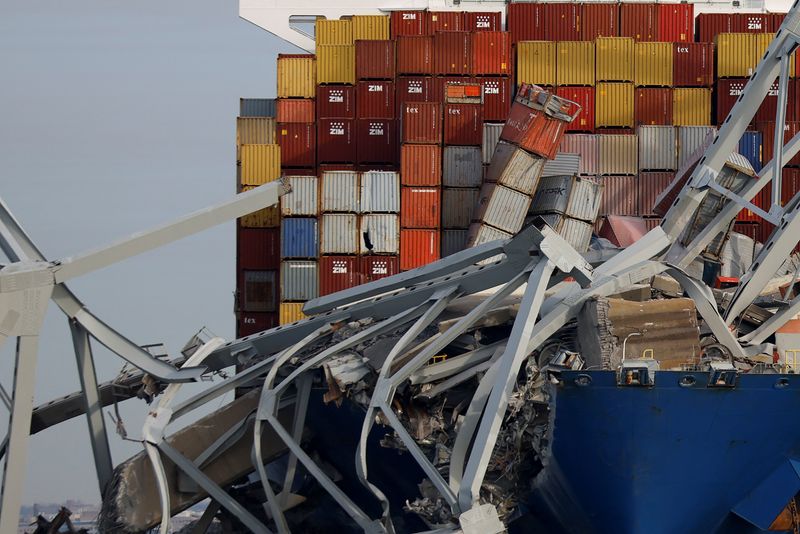By Lisa Shumaker
(Reuters) -Two bodies were recovered a day after a cargo ship crashed into Baltimore’s Francis Scott Key Bridge, with four people still missing and presumed dead after falling into the freezing water below. Authorities prevented people from using the bridge after the ship sent out a distress call, saving lives.
Rebuilding the bridge could cost $600 million and, according to initial estimates, it could take some time before the Port of Baltimore can reopen.
WHEN DID THE BALTIMORE BRIDGE COLLAPSE?
Shortly after 1 a.m. ET (0500 GMT), a container ship called the Dali was sailing down the Patapsco River on its way to Sri Lanka. At 1.24am he experienced a total power outage and all the lights went out.
Three minutes later, at 1:27 a.m., the container ship hit a bridge pylon, causing nearly the entire structure to collapse into the water.
The bridge was up to code and there were no known structural problems, Maryland Gov. Wes Moore said.
Tuesday’s disaster may be the worst bridge collapse in the United States since 2007, when a design flaw caused the I-35W bridge in Minneapolis to plunge into the Mississippi River, killing 13 people.
WHAT IS THE DEATH TOLL SO FAR?
Two bodies have been recovered and four people are still missing. Rescuers have given up hope of finding survivors. The six presumed dead included workers from Mexico, Guatemala and El Salvador, according to the Mexican consulate in Washington.
Efforts focused on searching for bodies in the 50-foot-deep waters surrounding the twisted ruins.
At the time of the accident, a construction crew was repairing potholes on the bridge and eight people fell 56 meters (185 feet) into the river where the water temperature was 47 F (8 C). Two workers were rescued, one unharmed and one injured.
According to Federal Aviation Administration research, this is the upper limit of what a human could survive falling into water.
Authorities saved lives by preventing vehicles from using the bridge after the ship sent a distress call, Maryland’s governor said.
The ship also dropped anchors to slow the ship, giving transportation authorities time to clear the deck.
WHY DID THE BRIDGE COLLAPSE?
The metal truss-style bridge has a suspension bridge, a design that contributed to its collapse, engineers say. The vessel appears to have struck a concrete main pier, which rests on the ground underwater and is part of the foundation.
WHO WILL PAY THE DAMAGES AND HOW MUCH WILL THE BRIDGE COST?
President Joe Biden promised to visit Baltimore soon and said he wanted the federal government to pay to rebuild the bridge.
The Department of Transportation can award “quick-release” emergency relief funds that typically amount to a few million dollars. To replace the bridge, Congress would have to approve funding. After the Minnesota bridge collapse in 2007, Congress appropriated $250 million.
Initial estimates put the cost of rebuilding the bridge at $600 million, according to economic analysis firm IMPLAN.
Insurers could face billions of dollars in claims, analysts say, with an estimated cost of up to $4 billion, making the tragedy a record insurance loss for shipping.
HOW LONG DOES IT TAKE TO REBUILD THE BRIDGE?
Reconstruction could be a long process and will depend on whether the remaining structure can be recovered. It took five years to build the original bridge from 1972 to 1977.
Closing the port for just one month would cost Maryland $28 million in lost business, according to IMPLAN.
WHICH SHIP HIT THE BALTIMORE BRIDGE?
The Dali was leaving Baltimore en route to Colombo, Sri Lanka.
None of the 22 crew members were injured, the ship’s manager, Synergy Marine Group, said.
The registered owner of the Singapore-flagged vessel is Grace Ocean Pte Ltd, LSEG data shows. The ship measures 948 feet (289 meters), which is the size of three football fields placed back-to-back. It was full of containers but was capable of carrying double the load. Security investigators recovered the ship’s black box, which can reveal the ship’s position, speed, course, radar, bridge audio, radio communications and alarms.
The same ship was involved in an accident in the port of Antwerp, Belgium, in 2016, when it hit a quay while trying to leave the North Sea container terminal.
A subsequent inspection in June 2023 in San Antonio, Chile, found the ship had deficiencies in its “propulsion and auxiliary mechanisms,” according to data published on the public website Equasis, which provides information on the ships.
WHAT DO WE KNOW ABOUT THE BRIDGE THAT COLLAPSED?
The Francis Scott Key Bridge was one of three ways to cross the Baltimore Harbor and handled 31,000 cars per day or 11.3 million vehicles per year.
The steel structure is four lanes wide and sits 56 meters above the river.
It opened in 1977 and crosses the Patapsco River, where US national anthem writer Francis Scott Key wrote the “Star Spangled Banner (NASDAQ:)” in 1814 after witnessing the British defeat at the Battle of Baltimore and the British bombardment of Fort McHenry.
WHAT EFFECT WILL THE COLLAPSE OF THE BRIDGE HAVE ON THE PORT OF BALTIMORE?
Traffic was suspended in the port, the 17th largest in the country.
The flow of containers to Baltimore will likely be redistributed to larger ports. However, there could be major disruptions in the shipping of cars, coal and sugar.
It is the busiest U.S. port for auto shipments, handling at least 750,000 vehicles in 2023, according to Maryland Port Administration data.

As of 2023, the port was the second busiest for coal exports.
It is also the largest port in the United States in terms of volume for handling agricultural and construction machinery, as well as agricultural products such as sugar and salt.